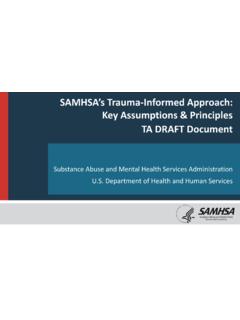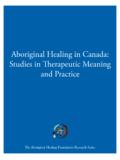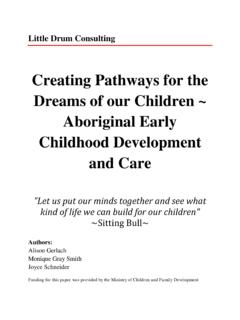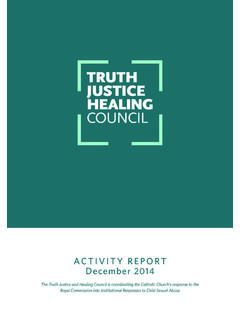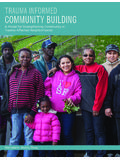Transcription of STRONG AT THE BROKEN PLACES: Turning Trauma Into …
1 < strong >STRONGstrong > AT THE. < < strong >STRONGstrong > >BROKENstrong >STRONGstrong > > PLACES: < strong >Turningstrong > < strong >Traumastrong > Into Recovery A Study and Resource Guide for use with the film " < strong >STRONGstrong > at the < < strong >STRONGstrong > >BROKENstrong >STRONGstrong > > Places". This film was produced with the support of The Harvard Pilgrim Health Care Foundation Massachusetts Cultural Council Cambridge Documentary Films, Inc. PO Box 390385. Cambridge, MA 02139-0004. (617)484-3993. Edited by Cozette Carroll and Jill Kooyoomjian This study guide was created with the support of: Harvard Pilgrim Health Care Foundation Massachusetts Cultural Council Gardiner Howland Shaw Foundation Ratshesky Foundation Paul Robeson Fund for Independent Media FORWARD. By Susan P. Pauker, MD. President and CEO of Harvard Pilgrim Health Care Foundation Co-Producer of < strong >STRONGstrong > AT THE < < strong >STRONGstrong > >BROKENstrong >STRONGstrong > > PLACES . < strong >STRONGstrong > at the < < strong >STRONGstrong > >BROKENstrong >STRONGstrong > > Places is a film about < strong >Turningstrong > . Four humans, severely traumatized by life's circumstances, choose to turn away from grief and pain and head toward healing.
2 They could not control the circumstances of their < strong >Traumastrong > , but they chose to control their responses. From the point, deeper in despair than most of us can imagine surviving, the featured speakers turned, arose, and chose a life of strength. Having accessed love, or laughter, or constant kindness, they chose to mend at their < < strong >STRONGstrong > >BROKENstrong >STRONGstrong > > places. This healing took the form in each case of giving back, of helping to fix the societal ills from which they had almost died spiritually. Most Americans have not personally suffered through war. Yet all of us have endured some form of < strong >Traumastrong > to our souls. Our parents were human and, therefore, imperfect. Harsh words, a back hand to the rump, a cry of stupid! or lazy! have crushed our spirits and limited our horizons. School bullies, test scores, temptations of drugs or sex, illness, poverty and man's inhumanity to man have all left us with < < strong >STRONGstrong > >BROKENstrong >STRONGstrong > > spots. Like damaged DNA, these fractures get passed on to the next generation, aided by alcohol, addictions, negative societal and parental role models.
3 The job for all of us is to crash through the cycle of violence, choose to heal ourselves from our vast or minor injuries, access love and support around us, arise, and correct for our children and others the very circumstances which tried our own spirits and from which we now can draw strength. < strong >STRONGstrong > at the < < strong >STRONGstrong > >BROKENstrong >STRONGstrong > > Places shows us four hurt humans as they recall their < strong >Turningstrong > points and struggle to return the gift of life to others who desperately need their respect, strength, and hope. These three elements are at the core of Harvard Pilgrim Health Care Foundation's mission as we seek, through endeavors such as this film, to enhance the health of society. Susan P. Pauker, MD. Assistant Professor of Pediatrics, Harvard Medical School President and CEO, Harvard Pilgrim Health Care Foundation 2. TABLE OF CONTENTS: Introduction .. 4. Update ..5. PEOPLE IN THE FILM. Arn Chorn Pond Biography .. 6.
4 Michael MacDonald Biography ..7. Marcia Gordon Biography ..8. Max Cleland Biography ..9. < strong >Turningstrong > It Around; Survival Plans Arn Chorn Pond's Survival Plan ..10. Michael MacDonald's Survival Plan ..11. Marcia Gorton's Survival Plan ..13. Max Cleland's Survival Plan ..14. CURRICULA FOR USE WITH THE FILM. Using " < strong >STRONGstrong > at the < < strong >STRONGstrong > >BROKENstrong >STRONGstrong > > Places: < strong >Turningstrong > < strong >Traumastrong > into Recovery" with: Mental Health Professionals by Linda T. Sanford ..15. General Audiences, < strong >Traumastrong > and Violence Workshops by Peace At Home..20. High School Students and Youth Groups by Joanne Coakley .. 25. Outline and LifeMap Exercise ..26. Veterans by Larry Winters .. 28. "America" by Larry Winters ..31. People With Disabilities by Michael Ferriter ..32. Veterans with Spinal Cord Injuries by Sigmund Hough Pastoral Care Workers by Ralph Fuccillo ..36. Offering Support to ..38. Adult & Youth Offenders and Correctional Officers by Cozette Carroll.
5 39. LITERATURE ON < strong >Traumastrong > AND RECOVERY. "Crime and Memory" by Judith Lewis Herman, A Review of the Literature on < strong >Traumastrong > and Recovery by Mary Baures, PhD..51. < strong >Traumastrong > of Victimization bulletin by the National Victim Center ..58. Post Traumatic Stress Disorder (PTSD) bulletin by the National Victim Center ..59. STATISTICS AND RESOURCES. Crime & Victimization Statistics ..60. Does America Have a Problem With Guns? ..61. Incest & Sexual Abuse Statistics .. 62. Where to Start in Your Community?..63. Regulations on Weapons .. 64. Education to Reduce Injuries from Firearms .. 65. Internet ..66. Contact ..67. Bibliography ..68. 3. " < strong >STRONGstrong > at the < < strong >STRONGstrong > >BROKENstrong >STRONGstrong > > Places" is a 38 minute documentary about people devastated by < strong >Traumastrong > and loss who find common ground for their journeys to recovery. The latest production from Cambridge Documentary Films, " < strong >STRONGstrong > at the < < strong >STRONGstrong > >BROKENstrong >STRONGstrong > > Places" is the story of vastly different lives.
6 The death camps of Cambodia, the violent streets of South Boston, the amputee ward of a hospital and the cell of an alcohol and drug addicted inmate yield remarkable survivors, all of whom heal themselves by helping others. Their stories are both inspirational and instructional, helping to infuse the word "hero" with meaning for our daily lives. Most of us have or will face serious < strong >Traumastrong > in our lives. As one of the people in the documentary explains, "Sooner or later life breaks us all, but with courage, hope and the support of people who care, many become < strong >STRONGstrong > at the < < strong >STRONGstrong > >BROKENstrong >STRONGstrong > > places.". Whether it is the death of loved ones, family or personal illness, crime and tragedies all take their toll. But by reaching out to others we can become "wounded healers,". and in so doing find our way to recovery and meaning. " < strong >STRONGstrong > at the < < strong >STRONGstrong > >BROKENstrong >STRONGstrong > > Places: < strong >Turningstrong > < strong >Traumastrong > into Recovery" shows how deep personal loss can be turned into a powerful tool for restoring hope and changing society.
7 4. < strong >STRONGstrong > AT THE < < strong >STRONGstrong > >BROKENstrong >STRONGstrong > > PLACES UPDATE: Arn Chorn Pond returned to Cambodia in July of 1998 with a video camera. He successfully organized a meeting of the Khmer Rouge and Cambodian Government in his home province. The purpose of this historical event was to convince both sides to put an end to the kidnapping and killing of innocent civilians in Cambodia. He also continues to work with the organization he founded in Cambodia, Cambodian Volunteers for Development, and remains the youth coordinator at Cambodian Mutual Assistance in Lowell, MA. Michael MacDonald recently completed his book about life growing up in South Boston and his family's experiences with crime and violence. The book, All Souls: a Family Story from Southie, is published by Beacon Press in Boston and available in bookstores and at Marcia Gordon is on the lecture circuit showing < strong >STRONGstrong > at the < < strong >STRONGstrong > >BROKENstrong >STRONGstrong > > Places and speaking to audiences about < strong >Traumastrong > and domestic violence.
8 She works at the Elizabeth Stone House as the support groups coordinator and is President of the Board of the Human Rights Agency, Peace at Home. Max Cleland is a US Senator representing the state of Georgia. Update: Since the releasing of < strong >STRONGstrong > at the < < strong >STRONGstrong > >BROKENstrong >STRONGstrong > > Places there have been several juvenile homicides in the City of Boston, although the numbers are still extremely low. 5. ARN CHORN POND. The early memories of Arn Chorn's childhood in Cambodia were like a lovely dream, the colors, smells and music of his world suffusing his life with love and happiness. But suddenly this eight year old child was thrown into a nightmare that gripped his entire country. An army of young Cambodians known as the Khmer Rouge emerged from years of brutal jungle warfare and began an insane campaign of revenge against their own citizens. Along with millions of others, Arn and his family were driven from their homes and forced into concentration camps.
9 These were the Killing Fields; half of the Cambodian population was eventually enslaved, tortured and killed in the name of "communist" revolution. For the next two years, Arn lived in horror no child should ever face. One by one, his family was taken away - he never saw them again. The Khmer Rouge beat and murdered thousands before his eyes. In order to survive Arn had to live like an animal, hiding his most basic human feelings. In 1979, Vietnam invaded Cambodia in an attempt to gain control over the madness on their southern border. The Khmer Rouge handed Arn, now eleven or twelve years old, a rifle and forced him to the front to fight the Vietnamese. After months of terror and killing, Arn escaped into the jungle, fleeing the sounds of war. Weighing less than fifty pounds and hovering on the edge of death, he made his way to a refugee camp in neutral Thailand. Adopted by a remarkable American rescue worker, Arn came to live in the United States with his new family of adopted refugees and orphans.
10 For the first time in years, Arn was free from physical danger. But now he faced the task of starting a new life, without forgetting the people he left behind. Sadness, anger and guilt raged within him. Why was he alive when so many others had died before his eyes? How could he ever trust another human being? Seeing him struggling with violent rages and suicidal feelings, Arn's adoptive father urged him to speak to others about his life, and Arn slowly began to heal himself by reaching out to other young survivors of war, and by talking to other Cambodian refugees about their common tragedy. Since then, Arn's life has been a whirlwind. He spent ten years as a speaker for Amnesty International and co-founded Children of War, an organization that traveled the country educating young people about the devastating effects of war. Later he returned to Cambodia to create a 3000 member organization to help rebuild his country.

